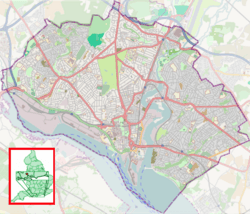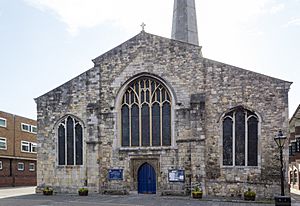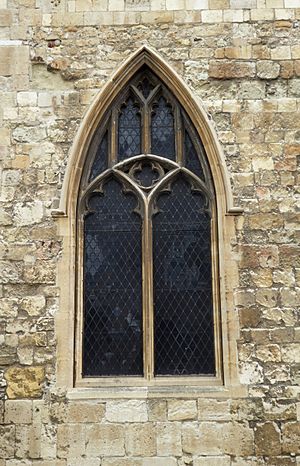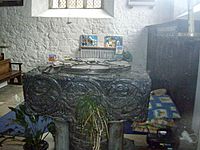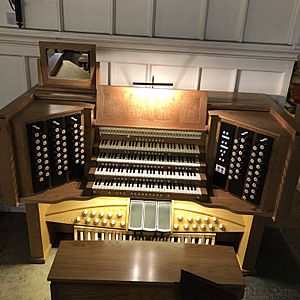St Michael's Church, Southampton facts for kids
Quick facts for kids St Michael's Church, Southampton |
|
|---|---|
| Church of St. Michael | |
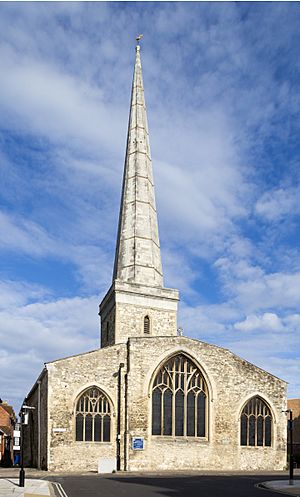
The Parish Church of St Michael, Southampton
|
|
| 50°53′59″N 1°24′19″W / 50.89959°N 1.40515°W | |
| Location | Southampton, Hampshire |
| Country | England |
| Denomination | Anglican |
| Website | Parish of St Michael's, Southampton |
| History | |
| Status | Parish church |
| Founded | 1070 |
| Dedication | St. Michael |
| Architecture | |
| Functional status | Active |
| Heritage designation | Listed building – Grade I |
| Architectural type | Church |
| Style | Norman |
| Completed | Last major re-building 1872 |
| Specifications | |
| Spire height | 165 ft 0 in (50.29 m) |
| Materials | Ashlar |
| Administration | |
| Parish | St Michael's, Southampton |
| Deanery | Southampton |
| Archdeaconry | Bournemouth |
| Diocese | Winchester |
| Province | Canterbury |
St. Michael the Archangel Church is the oldest building still used in Southampton, England. It was founded in 1070. This church is the only one still active from the five original churches in the medieval walled town. It is a very important building, listed as Grade I.
Contents
Where to Find St. Michael's Church
The church is on the east side of St Michael's Square. This is in the heart of Southampton's Old Town. It is across from the Tudor House Museum. In medieval times, a fish market was in St Michael's Square.
The Long History of St. Michael's Church
After the Norman Conquest of England, the town of Southampton moved. It shifted west from the older Saxon settlement of Hamwic. The new location was higher ground near the River Test.
How the Church Began
Archaeological findings show the church started in 1070. It was named after St. Michael, a patron saint of Normandy. The first church was shaped like a cross. The oldest parts you see today are the lower levels of the central tower.
The first written record of St. Michael's was in 1160. King Henry II gave the church to the monks of St. Denys Priory. The monks looked after it until 1537. Then, the church became property of the Crown.
Growth and Challenges in Medieval Times
Southampton became a very important port in England during the Middle Ages. St. Michael's Church grew along with the town. Chapels were added to both sides of the main church area in the 1200s.
In October 1338, French raiders attacked the town. The church was badly damaged by fire. Wooden buildings nearby were completely destroyed. The Hundred Years' War and the Black Death hurt the town's growth. But by the late 1300s, Southampton became rich again. This was thanks to the wine trade.
In the late 1300s, the north side of the church was made wider. The south side and the west door were rebuilt in the 1400s. This gave the church its almost rectangular shape. The church's first tall spire was built in the 1400s. By the early 1500s, a special chapel extended from the south side.
Years of Neglect and Renewal
From the mid-1500s, Southampton's importance as a port went down. The church also suffered from neglect. The special chapel was even used as a house and a barber's shop. It was pulled down around 1880.
In 1836, a new vicar, Rev. T. L. Shapcott, started a big project. He added new seats and raised the floor. The aisles were made taller, and the north aisle was extended. The roof was rebuilt to a lower angle. New galleries were added. The old stone pillars were replaced with brick and cast-iron ones. This big project cost the church £2,390.
In 1872, the new galleries had to be removed. They were causing damage to the building.
The spire was first built in the 1400s and rebuilt in 1732. In 1887, 9 feet were added to make it taller. This helped ships use it as a landmark. It is now 165 feet high.
Surviving World War II
During World War II, much of Southampton was destroyed by bombs. This was known as the Southampton Blitz. Other churches in the town center were destroyed in 1940. But St. Michael's only had minor damage. People say this was because German pilots used the spire as a landmark. They were told not to hit it.
In the 1960s, the whole church was restored. This cost £36,000. The work finished just in time for the church's 900th anniversary in 1970.
Exploring the Church's Features
Outside the Church
The west wall has parts of the original Norman design. It also has a doorway from the 1400s. You can still see where the original roof line was before it was raised.
The south wall has pieces of round pillars from the original Norman church. These were moved and put into the wall when it was made taller. A large arch that led to a chapel is now filled in.
The east wall has parts from the 1100s at its bottom. The outside corner of the 1100s church still sticks out from the current wall.
The north wall has a doorway with a nicely shaped arch from the 1400s.
The 165-foot-high spire has a weather vane on top. This is a golden cock that is 3 feet 3 inches long. It was put on the spire when it was rebuilt in 1733.
Inside the Church
The walls are about 3 feet 10 inches thick. They have rounded arches towards the main church areas. These arches are all the same width.
The chancel (the area around the altar) is 22 feet 6 inches square. The lower part of the east wall is from the 1100s. There is a special basin for water (a piscina) from around 1260. There is also another piscina from the 1400s.
The north and south chapels are next to the chancel. They open to the chancel with beautiful arches. The south chapel is now used as a vestry (a room for clergy). It has a window similar to the north chapel. A 15-foot-wide arch (now blocked) led to another chapel. The organ is above the choir vestry. A screen separates this area from the south aisle. This screen has the only medieval wood left in the church.
The north chapel was once called the Mayor's Chapel. Until 1835, the mayor was sworn into office here. The chapel's window has designs from the 1400s. In the window frame, you can see a merchant's mark. This was a symbol of the Woolstaplers' Guild. Across from the north door is a piscina from the 1200s.
The south wall is from the 1400s and has two windows from that time. The north wall has two windows from the late 1300s. Next to the second window is a blocked doorway. Near it is a holy water stoup from the 1400s.
Church Windows
The East Window shows the five churches of medieval Southampton. These were St. John's, St. Lawrence, St. Michael's, Holyrood, and All Saints'.
The West Window shows St Michael defeating a dragon.
Church Furnishings
The Font
The font was made around 1170. It is carved from a single block of black Tournai marble. This is one of only four such fonts in Hampshire. The pillars of the font are made from Purbeck Marble.
Lecterns
The church has two brass lecterns (stands for reading). One was saved from Holyrood Church during the 1940 bombing. It is one of the oldest (from the 1300s or early 1400s) and most beautiful in England. It has a detailed eagle's body and wing feathers. The other is also a fine brass eagle from around 1450.
Tombs and Memorials
The most famous tomb in the church belongs to Sir Richard Lyster (c.1480–1554). He was a very important judge. His tomb was built in 1567. It is in the north-east corner of the church. It shows early designs with fluted columns.
Near the north-east corner of the tower is part of a gravestone from the 1100s. It is made of Purbeck Marble. It has a carving of a bishop holding a crozier (a shepherd's crook).
High on the south wall is a memorial to Bennet Langton. It includes a special message written by his close friend, Samuel Johnson.
Music and the Organ
The choir of St Michael's is called Cantores Michaelis. These are students from the University of Southampton. They sing every Sunday and on special days during the school year. The group started in 2000. They sing music written for Christian services without instruments.
The first organ was built in 1880. It was made bigger in 1950 and rebuilt in 1986. More improvements were made in 1995. In December 2016, the pipe organ was replaced. The new organ is a digital copy of a famous organ from Hereford Cathedral. It was built by Romsey Organ Works.
Church Bells
From the 1600s until 1878, the church had six bells. In 1878, two more bells were added. One of these was very thin and needed repair later. In 1923, all the bells were recast (melted down and reshaped). They were hung in a new iron frame. In 1947, two more bells were made. The metal for these came from the ruins of Holyrood Church. St. Michael's is one of only six churches in the Diocese of Winchester with ten bells.
See also
- St. George's Episcopal Memorial Church, a church in the US with a stained glass window containing shards of glass collected from this church when it was damaged in World War II.


